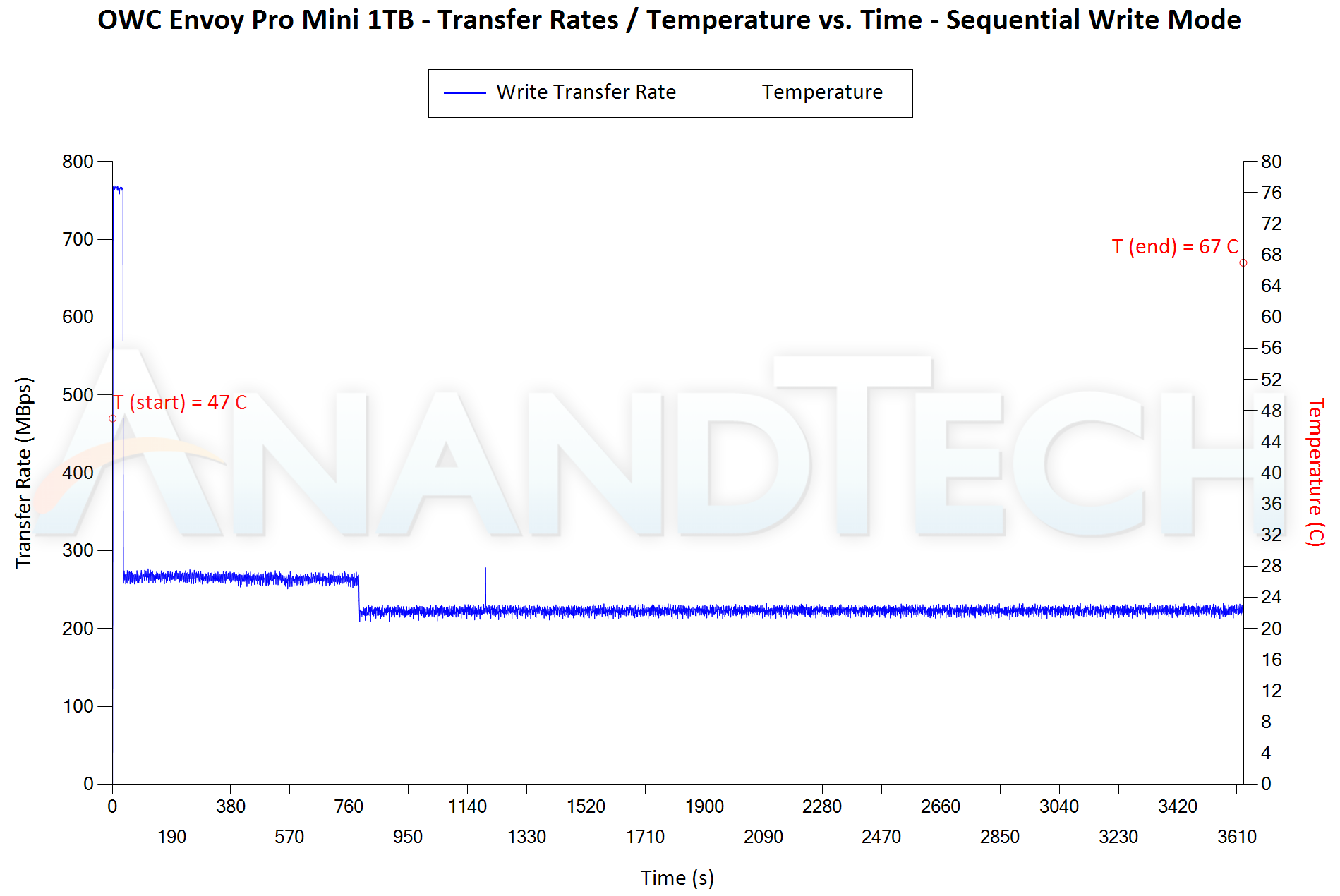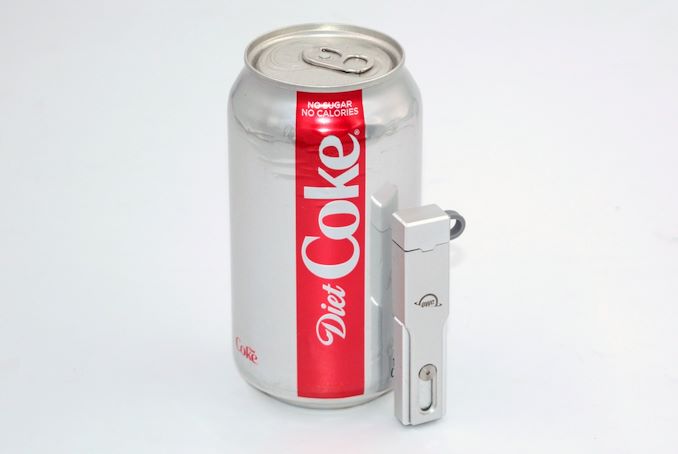OWC Envoy Pro Mini Review: SSD in a Thumb Drive Exceeds Expectations
by Ganesh T S on March 2, 2023 8:00 AM EST- Posted in
- Storage
- SSDs
- Flash Drive
- OWC
- flash
- Phison
- DAS
- Type-A
- Type-C
- USB
- USB 3.2 Gen 2
- Portable SSDs
Miscellaneous Aspects and Concluding Remarks
The performance of the storage bridges / drives in various real-world access traces as well as synthetic workloads was brought out in the preceding sections. We also looked at the performance consistency for these cases. Power users may also be interested in performance consistency under worst-case conditions, as well as drive power consumption. The latter is also important when used with battery powered devices such as notebooks and smartphones. Pricing is also an important aspect. We analyze each of these in detail below.
Worst-Case Performance Consistency
Flash-based storage devices tend to slow down in unpredictable ways when subject to a large number of small-sized random writes. Many benchmarks use that scheme to pre-condition devices prior to the actual testing in order to get a worst-case representative number. Fortunately, such workloads are uncommon for direct-attached storage devices, where workloads are largely sequential in nature. Use of SLC caching as well as firmware caps to prevent overheating may cause drop in write speeds when a flash-based DAS device is subject to sustained sequential writes.
Our Sequential Writes Performance Consistency Test configures the device as a raw physical disk (after deleting configured volumes). A fio workload is set up to write sequential data to the raw drive with a block size of 128K and iodepth of 32 to cover 90% of the drive capacity. The internal temperature is recorded at either end of the workload, while the instantaneous write data rate and cumulative total write data amount are recorded at 1-second intervals.
| Sequential Writes to 90% Capacity - Performance Consistency | |
| TOP: | BOTTOM: |
 |
|
 |
|
The SLC cliff for the OWC Envoy Pro Mini is around 24GB, after which write speeds drop down from 760 MBps to 270 MBps. Around 220GB, we get another small cliff where the writes go down to 220 MBps. The temperature of the internals at the end is around 67C (though we saw temperatures of around 78C in the DAS suite performance consistency section). Guaranteed write speeds for sequential accesses of more than 200 MBps is impressive for a thumb drive, and a comparison against the two DataTraveler Max SKUs in the above show that the Envoy Pro Mini is indeed praiseworthy in this aspect.
Power Consumption
Bus-powered devices can configure themselves to operate within the power delivery constraints of the host port. While Thunderbolt ports are guaranteed to supply up to 15W for client devices, USB 2.0 ports are guaranteed to deliver only 4.5W (900mA @ 5V). In this context, it is interesting to have a fine-grained look at the power consumption profile of the various external drives. Using the Plugable USBC-TKEY, the bus power consumption of the drives was tracked while processing the CrystalDiskMark workloads (separated by 5s intervals). The graphs below plot the instantaneous bus power consumption against time, while singling out the maximum and minimum power consumption numbers.
| CrystalDiskMark Workloads - Power Consumption | |
| TOP: | BOTTOM: |
 |
|
 |
|
A peak of just 1.83W is impressive for the Envoy Pro Mini, and the drive can pretty much turn itself off and idle at close to 0W after around 20 minutes of traffic absence. We do see garbage collection kick in automatically after extended idling (causing the power numbers to spike), and that helps keep the drive in good fettle over the long run. In comparison, the DataTraveler Max SKUs peak at 2.31 W (Type-A) and 3.05 W (Type-C). It must be noted here that we tested the power consumption numbers with the Type-C adapter active.
Final Words
The OWC Envoy Pro Mini has been available for purchase for a couple of quarters now. The street prices are $78 (250 GB), $90 (500 GB), and $130 (1 TB). A comparison of the DataTraveler Max prices at the corresponding capacity points shows that OWC places a premium on the enclosure design - the gap is around $40 for the 250 GB version, and it progressively becomes smaller to just $24 for the 1 TB version. For the premium, the end user gets a highly durable and attractive enclosure that is compatible with a wide variety of computing devices (thanks to its dual interface support). The internal flash device also performs more consistently for stressful workloads.
The Envoy Pro Mini was compared against a host of other 1 TB external flash drives in the preceding sections. However, the key comparison is within its own niche, where it goes up against the Kingston DataTraveler Max. For short bursts, the DataTraveler Max comes out on top in almost all types of workloads. However, under extended use conditions, the Envoy Pro Mini delivers higher absolute performance numbers. This puts more stress on the thermal design, and the Envoy Pro Mini manages to handle it. Despite the higher temperatures during the course of use, the drive does not throttle.
On the internal configuration front, the Envoy Pro Mini delivered a nice surprise. When the Phison U17 was launched in early 2021 after having been teased at the 2019 Computex, its claimed performance numbers were rather anemic. Understandably, this native UFD controller was relegated to the mid-range and entry-level offerings. With NAND layer counts and performance numbers ramping up at a steady pace, it is likely that the U17 has seen some minor updates to support the latest NAND generations - OWC is probably using the new NAND to deliver performance numbers that surpass Phison's initial claims easily. Similar to previous Phison designs from OWC, the SLC cache is rather small. We would like to see SLC cache sizes in the 10% range (rather than the 2.4% adopted for the 1 TB model) as long as other performance metrics (particularly in the extended stress scenario) are not negatively affected.
OWC deserves plaudits for bucking the usual trend of vendors trying to slap on the the highest possible performance numbers in the product packaging. In our opinion, the slightly lower peak performance numbers are more than made up for by the performance consistency under extended use, as well as optimized power consumption numbers (particularly when used with battery-operated devices). Overall, the Envoy Pro Mini has come out as a credible challenger to the pole position enjoyed by the Kingston DataTraveler Max series in the 'SSD in a thumb drive' market segment.











18 Comments
View All Comments
ikjadoon - Thursday, March 2, 2023 - link
I almost bought this a few weeks ago, thinking it had some water resistance. Turns out, none.Unfortunately to me, drives that fit onto a keychain will one day end get exposed to the rain and I'd hate to lose a $90 or $120 SSD that way.
Otherwise, it's perfect. They've nailed the sneakernet re: performance, compatibility, and form factor.
ballsystemlord - Thursday, March 2, 2023 - link
If you actually read the review, you'll find that this drive has poor performance compared to its rivals.Also, I'm uncertain how "USB thumb drive" would ever be classified as a "form factor". They literally come in many shapes and sizes.
Wrs - Thursday, March 2, 2023 - link
It did fine. The rivals are either 2-2.5" connected by cable (T7, Envoy Pro) or a thin proper thumb drive that forces you to choose USB A/C and stutters to 50MB/s transferring large loads (DataTraveler).Thumb is an important form factor for some - keychain portability and not blocking adjacent USB ports. The compromise is thermal dissipation, and review shows Envoy Mini is more efficient than DTMax.
ikjadoon - Friday, March 3, 2023 - link
If you actually read my comment (jeez, such hostility from someone that's wrong…), you notice I wrote for sneakernet.For that, the form factor is much better: no flailing cables, not too large even for small pockets, not too large to block adjacent ports, light enough to keep on you 24x7, durable caps, etc.
How do you not understand that a USB flash drive can have multiple form factors? How do you misread a comment so badly? See, I wouldn't post a comment if I was as confused as you.
Sigh….
ballsystemlord - Friday, March 3, 2023 - link
I did not actually have pictures of the other items to compare so I had no idea this USB thumb drive was being compared to non-USB thumb drive devices. I did check that they were all USB connected devices before posting.Regarding sneakernet, I did not cache the reference. I thought that practice was actually dead.
Now that I understand I have to say that USB thumb drives, at least several that I have owned, do block the other USB ports. To the point where I bought a 6in extension cable. It doesn't take much to block the next port over.
PeachNCream - Friday, March 3, 2023 - link
Absence of waterproofing may not be a significant problem. As someone with a history of running USB storage through laundry (4 different drives so far - wash and high temp dry - two of them have been neglected in that manner multiple times), nothing I've done has caused a failure. One even survived as a bare PCB after the cheap plastic casing came apart. I just reassembled the plastic parts and its currently held together with masking tape. You'd be surprised how durable solid state storage can be even when neglected and abused.fazalmajid - Thursday, March 2, 2023 - link
So you should be able to ditch the bulky A-to-C adapter by unscrewing the Torx screws. I've been looking a long time for a good replacement for my 2015 vintage Lexar Jumpdrive P20. The plastic construction of the Kingston or SanDisk Extreme rule them out. The dual A and C swiveling SanDisk Ultra Drive Luxe is convenient and it's available in capacities up to 1TB but it's also very slow.Samus - Thursday, March 2, 2023 - link
I've had one of these for almost a year and am thrilled you reviewed it. After seeing it at CES last year (where I believe it was announced) I got one as soon as it came out and it's basically my entire IT portfolio (images, ISO's, tools, software) in a highly accessible portable fast enclosure.It's worth pointing out it is also bootable to the point you could run an entire system off it if need be. I have mine setup to boot WinPE.
ganeshts - Thursday, March 2, 2023 - link
For IT folks, that is the perfect use-case for these dual-interface high-performance thumb drives. I have been using an old 128GB NVMe SSD in a dual-interface 'thumb form-factor' enclosure (Akasa) for a couple of years now (with Medicat USB installed).Since the use-case is mostly read-heavy after the initial loading, something like the Envoy Pro Mini is a good enough alternative. Despite not emerging the outright victor in any of the short-term benchmark numbers, I think OWC has a winner here. Some additional SLC cache would be nice to have, but that is nit-picking at this stage.
Hopefully, OWC keeps improving this product with newer NAND generations and controllers (Gen 2x2 / USB4 etc.)
ViRGE - Thursday, March 2, 2023 - link
I like the performance, but the fact that this isn't natively USB-C is a downer. It's 2023, and OWC is a company that has its roots in providing Mac accessories. It should be a USB-C drive with an adapter for A, not the other way around. After all, it's not like USB-A adoption is increasing over time.